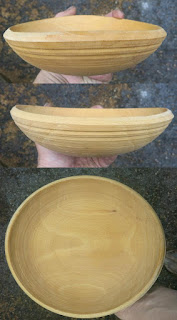A lot of you will know how wood moves, but if you are starting out then it can all be a bit of a mystery. In order to work competently with wood we must know how wood moves as it shrinks and dries. It can be easy to get caught out and find that the project you have been working on has now warped or shrunk in such a way that is no longer saleable.
The above diagram should be self explanatory. Tangentially cut wood is also know as through and through cut or flat sawn, and I am sure is also know by many other terms as well. (1) in the diagram is a radially cut, or quarter sawn wood. Radially cut wood can be more expensive because it is the most stable and often has lovely medullary ray patterns on the surface, as in quarter sawn oak, or lacewood in London plane.
The above photo are the aspen planks. The top plank in each photo is tangentially sawn wood. The bottom is radially sawn wood. The discs are oak turned green and allowed to dry. They have been arranged on the aspen planks to show the grain orientation and to give another visual way of seeing in what planes the wood shrinks.Click on the image to make it bigger.
Turned green oak and dried, then cut into discs. The measurements are 32.55mm and 28.88mm making a shrinkage of 3.67mm.
We can see that wood shrinks far more along the growth rings than across the growth rings.
Radial on the left; green size 83.10mm dried width 81.50mm which is a 1.6mm shrinkage
Tangentially cut on the right; 83.65 and dried width 78.50 which is a 5.15mm shrinkage.
Radial on the left 29.15mm green, 28.21mm dry, 0.91 shrinkage
Tangentially cut on the right, green 29.05 green, 28.58 dry, 0.47 shrinkage.
This is a 19.5 inch wide oak plank 3 inches deep. There is no way that this could ever be planed down to 3 inch thick plank, you would be very lucky to get 2.5 inches deep planned plank from this. Note how it has shrunk more at the ends and is thicker in the middle. All flat sawn planks will cup, even kiln dried stock that has been planed and thicknessed flat will still have a tendency to cup over time.
I have not talked about dimensional change in the length, well there is none to speak of, especially in short lengths of wood. My bit was exactly the same length. I am sure there will be a slight reduction in length, but I have never set aside a 12ft plank and measured it green and dry.
This is how a bowl shrinks as it dries. I love how the wood always has the final say in pole lathe turned bowls.















No comments:
Post a Comment
Sorry, because of the huge amount of dubious people leaving spam comments for their useless stuff, I unfortunately have to bring back word verification.